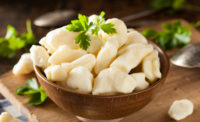Latin American cheese production in the United States has seen substantial growth over the last decade. Driven by the increase in the Hispanic population in the United States, which is now over 55 million, as well as increased consumer interest in specialty cheese, production has increased from around 167 million pounds 10 years ago to around 254 million pounds in 2015.
Sometimes called Hispanic cheeses, “Latin American” is probably the more proper term to use when referring to cheeses developed in Mexico, South America and the Caribbean (which has less of a Spanish influence). Of these varieties there are three distinct styles including fresh, melting and grating.
Each style and origin has a unique set of flavors, textures, packaging and applications, all of which are important to consumers. Understanding these elements is the key to success in this market, but it is important to understand the background on these styles, as well as the benefits and risks of manufacturing Latin American-style cheeses.
The cheesemaking history
The history of cheesemaking in Latin American countries started with the influx of Europeans and the subsequent mixing of European and Latin American cultures. As cheesemaking techniques spread, adaptations were made that were unique to each region. This has resulted in a variety of cheeses that has, in many cases, similar names but different make procedures or, sometimes, different names but the same make procedure.
Chihuahua is a good example of this confusing issue. Chihuahua originated in the Mexican state of Chihuahua. But in Chihuahua it is often called queso Menonita, as it was originally made and sold by the Mennonite communities that settled there. In the United States, however, the name Chihuahua has been trademarked so others are calling it queso quesadilla. This naming issue can be very confusing for consumers and manufacturers alike.
Keeping the cheeses safe
Moving past the naming issues, it’s also important to understand the differences between fresh, melting and grating cheeses. Fresh Latin American cheeses include para freir, blanco, panela, fresco and ranchero. These cheeses are high in moisture and pH. In general, these cheeses do not melt, can be crumbly and tend to have a very mild, milky flavor. They are generally reserved for salads, soups, bean dishes and other cooking or frying applications where a nonmelting cheese is desired.
While very versatile, manufacturers and consumers need to be aware of the higher food safety concerns with these cheeses since they have a high pH and high moisture content (thus have high water activity and low lactic acid content, both of which are important food safety hurdles).
Pasteurization of the cheese milk, very good sanitation and maintenance of adequate refrigerated storage temperatures are all important aspects to producing high-quality, safe fresh cheese. Research has also explored treatments like high-pressure processing and protective cultures to help reduce the food safety risks of these fresh cheeses.
Melting cheeses include Oaxaca, Chihuahua, Asadero and Manchego. These cheeses often have moisture levels in the 40% to 50% range and because the pH value is much lower at around 5.2, there is a reduced food safety risk. The key with these cheeses is that they melt. While styles such as Oaxaca are sometimes eaten as a snack cheese, generally, these cheeses are created for cooking applications, such as quesadillas and enchiladas. Again, the flavor is fairly mild and creamy with buttery and salty notes being the most detectable attributes.
The diversity of grating cheese
The third style, Latin American grating cheeses, offers a wide range of flavors including salty, grassy, fruity and nutty. Sometimes they have unusual flavors including fishy, smoky, barny and cowy. These cheeses tend to be aged, and textures are firm, hard and crumbly.
Shelf life is much longer than the fresh-style cheeses and these grating cheeses have much higher salt levels. It should be noted, however, that the traditional make procedures and unique microbiota found in the milk for many aged or grated Latin American cheeses can introduce flavors that some United States consumers might not appreciate.
As such, it’s important to know your target market and consider spending a bit more time in the product testing phase to see which flavor profiles work best with your audience. With such unique flavors, high salt and slightly higher fat, these cheeses make an excellent grated topping for a wide range of dishes.
In conclusion, the wide diversity and versatility of Latin American cheeses, as well as the changing demographics in the United States provide a great opportunity for further growth in the manufacture and utilization of Latin American-style cheeses.
Research is needed to help enhance the food safety of these fresh-style cheeses as well as knowledge on how to scale-up some of these artisanal cheeses into larger production facilities while retaining the authentic characteristics, which consumers have come to expect.




